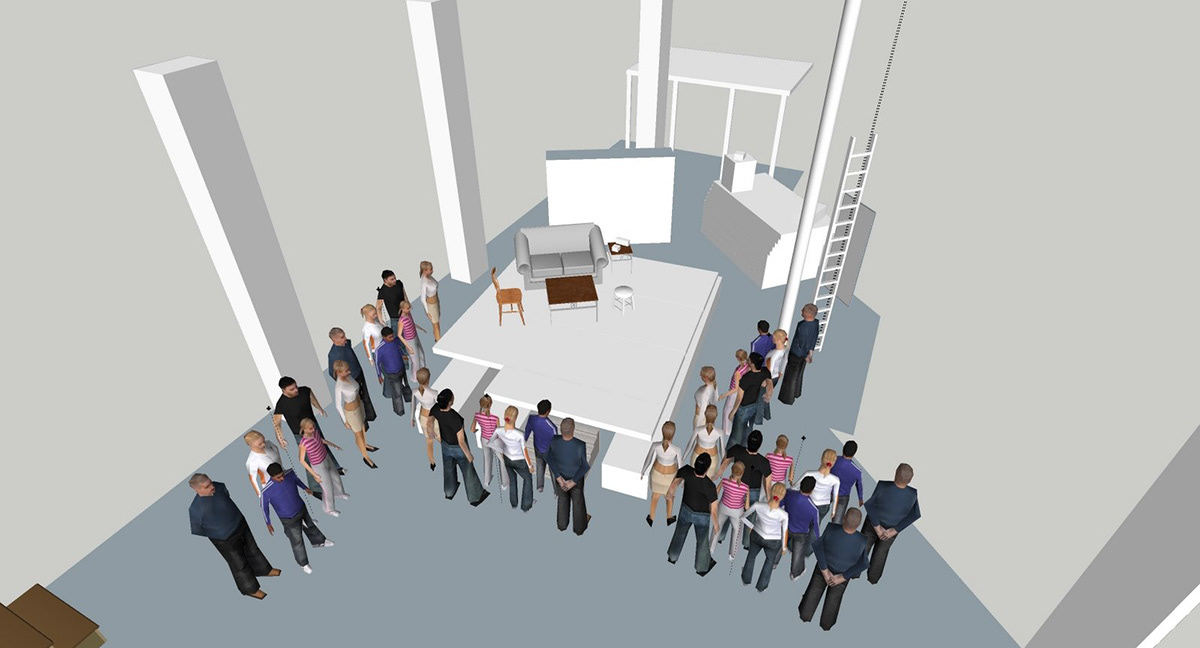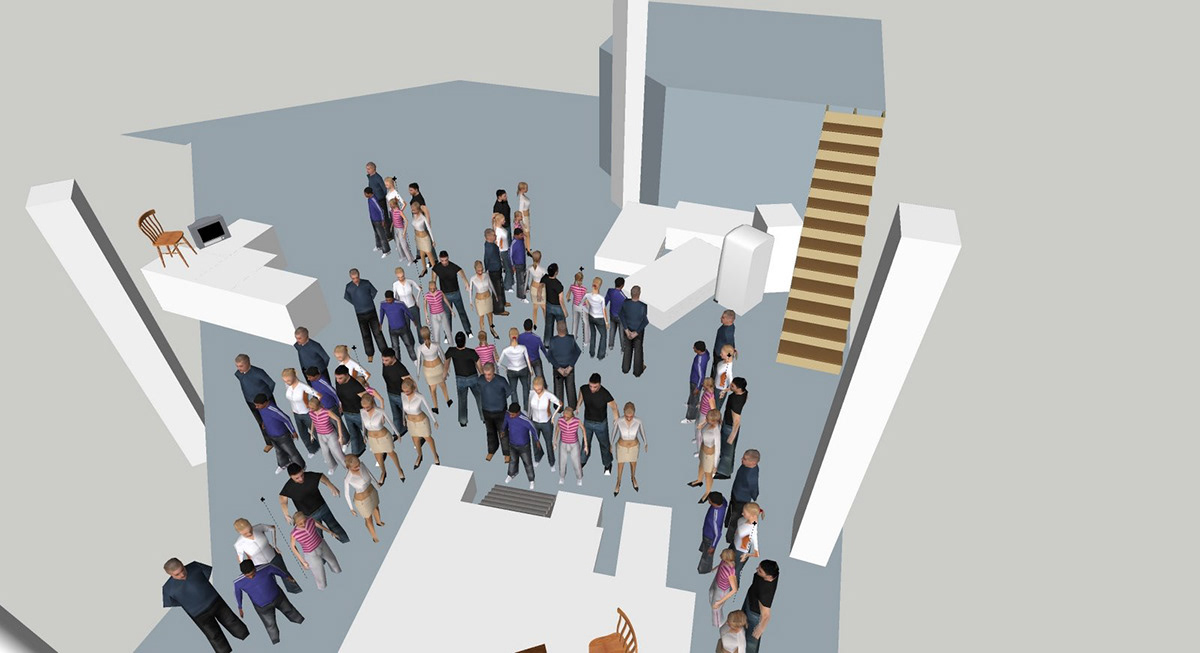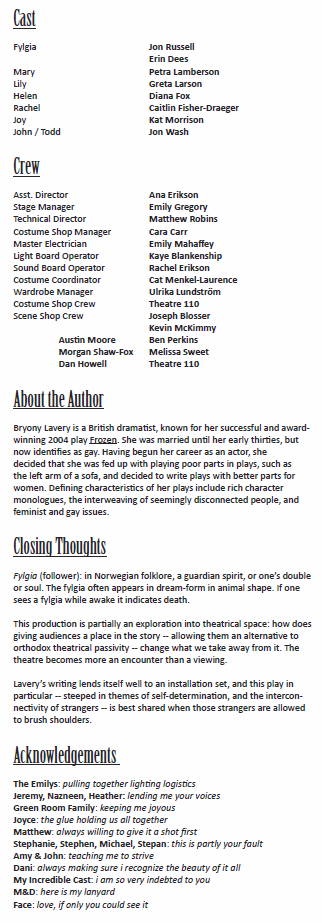Nothing Compares To You
Directing, Scenic Design, Sound Design
There are precious few times artists are given extensive resources and little oversight. Here’s what I did with mine.
There are precious few times artists are given extensive resources and little oversight. Here’s what I did with mine.

Nothing Compares to You was produced professionally only once in 1995 at the Birmingham Repertory Theatre. There are no reviews more than a few lines long and no production photographs, so I began directing the show with only two snippets of information: the play produced “audible gasps from audiences unused to seeing women kiss on stage,” and that “the fylgia were fun, but a bit of a sideshow”. Having been completely buried by the play’s passion – and problems – the first times I read it, I felt those comments – or the production itself – largely missed the central beauties of this play.
“Sinaed O’Connor is heard singing ‘Nothing Compares to You.’ A Fylgia is revealed. Sound of a cold cold wind. … It takes a saw from the sledge and saws a circle in the stage. Fishes down it. Catches fish after fish. … It fishes up an old tyre. A scream rings out. A dreadful sound of screeching tyres. Metal grinding against itself.”
“Sinaed O’Connor is heard singing ‘Nothing Compares to You.’ A Fylgia is revealed. Sound of a cold cold wind. … It takes a saw from the sledge and saws a circle in the stage. Fishes down it. Catches fish after fish. … It fishes up an old tyre. A scream rings out. A dreadful sound of screeching tyres. Metal grinding against itself.”
the PLAY
Like other plays by Bryony Lavery, this NC2U begins with a tragic accident which connects seemingly unrelated people. The first scene begins lightheartedly enough, with two Fylgias (or guardian spirits) ice fishing in a frozen landscape. They eventually fish out a car tire which inadvertently— or perhaps not— causes a terrible car accident in the “real world.” We then transition to witness Mary’s death; she has been cut in half in a car accident. She leaves a terrible mess of lives behind her, and the rest of the play gradually reveals the ordeals of the people surviving her. We see both the trials and conclusion of those lives.
In the first act, we get glimpses of handful of people existing in individual, self-isolated worlds. The act builds through a series of monologues which— detective-style— stitch together the characters through clues and clarifications. In the second act the characters are brought face to face with one another or their personal demons, and by the end of the play lives are either mended or ended. In this play, where the lives we see are living hells (with a few exceptions), the series of deaths that conclude the story seem like merciful releases.
Perhaps the piece sounds dismal in summary, but it covers a gamut of meaty issues — loss, betrayal, loneliness, homosexuality, and tenacity in the face of defeat — with a wry smile. Bryony deftly keeps one eye on the tragedy and one ear to the gallows humor. Furthermore, having the dead coming back to life and the prominent (but playful!) haunting of the space by the Fylgia give this play a hefty dose of the Fantastic, and asks the audience to look at these very immediate human stories in an other-worldly light.
Though there are currents running through it, I don’t think this play is fatalistic. Though Lavery shows us that some things happen in our lives which are beyond our control and understanding, it is only to encourage us to make the most of those choices that we are given.
“A sound of exotic bird song, insects. A Fylgia comes on, treading carefully. Another Fylgia comes on from the other side, treading carefully. They meet in the middle of a steamy rain forest. They sweat. One unwinds the long long long scarf from its neck. They get pestered by insects. Bitten. … Sound of heart-rending sobbing.“
“A sound of exotic bird song, insects. A Fylgia comes on, treading carefully. Another Fylgia comes on from the other side, treading carefully. They meet in the middle of a steamy rain forest. They sweat. One unwinds the long long long scarf from its neck. They get pestered by insects. Bitten. … Sound of heart-rending sobbing.“

Environmental Theater
“I believe there are actual relationships between the body and the spaces the body moves through.” –Richard Schechner
Theater is a spatial art: more so than any other art form the space in which the work is (or is not) contained and the audience’s physical relationship with that space and art has a profound impact on how the art is received by the audience.
Theater is a spatial art: more so than any other art form the space in which the work is (or is not) contained and the audience’s physical relationship with that space and art has a profound impact on how the art is received by the audience.
At its most basic level, Environmental Theater works from the starting point that the actors and spectators share a single performance space. Though from this one could go so far to say that Environmental Theater includes any type of performance without the proscenium stage -- folk and popular performances, buskers, parades, guerrilla theater. Inherent in the idea of Environmental Theater, however, is the significance of the chosen performance space. Where street performers and folk theater choose space according to where audiences will already be, the spaces in Environmental Theater –- be they outside, “found” or refurbished traditional spaces -– are in existence solely to tell the chosen story; these spaces are not merely found, they are cultivated.
Environmental Theater is disorienting for an audience. This is not exclusively bad or good, what is valuable is its ability to get audiences out of their comfort zones and give them fresh experiences. They literally engage with the material and each other: by getting them up close and personal to the trials of others, it cuts through the desensitization brought on by film and mass media. Also, each spectator’s experience of the work is unique: viewing from two different proximities on the same performer at the same point in the story may yield distinctive understandings simply due to unique vantage points; the story becomes an utterly personal experience. However, in Environmental spaces one runs the risk that the sheer newness of the event will alienate audiences, which will then disengage. Schechner and the Performance Group learned the hard way during many performances that if audiences are uncomfortable they will shut down; just because they bought a ticket doesn’t mean you can force people to participate.
"A Fylgia comes rowing on in a tiny makeshift boat. They ocean roars and sprays. The boat rides the tossing waves. The Fylgia goes from smiling to very seasick. It takes some 'Resolve'. The sea gets calmer. It decides to fish. Reels in a second Fylgia, who has been snorkelling. They put makeshift snorkel, flippers, air-bottle on the Fylgiain the boat. They both dive. They encounter shoals of fish, sea-horse, an octapus. They capture a large shark. They put a hand in the shark and start bringing out what it is in its stomach ... a car bumper, a tin of salmon, one of Lily's high-heeled shoes, a chocolate each, a black and white cat..."

Production Choices
"This is a place of great beauty and detritus. There are perches and vantage points, possibly trapezes and ropes and facilities for flying and swooping and soaring in and out of modern, rather cramped, sad rooms, roadways and locations in various parts of Great Britain."
The central concept of the play developed as the space and performers did, but from the very beginning I wanted to highlight the characters’ self-isolation; highlight choices missed and taken, good and bad; and stress the importance of making any choice over being passive with life. The concept then developed to use the space and spatial relations in various ways both as an active metaphor for story and its characters’ journeys, and also as a way for the audience to be directly linked to the story’s themes. I wanted to explore how giving audiences a place in the story -– allowing them an alternative to orthodox theatrical passivity -– changes what they take from it. I wanted theater as an encounter rather than a viewing.
Bryony’s writing style suits an installation set. With a script that moves as quickly as Nothing Compares, the stage would either have to be nearly bare –- with one location quickly transformed to others equally unspecific –- or to install a number of smaller sets so they become associated with a character and/or location in the story. This second option allowed me to accomplish another metaphorical goal to communicate their respective emotional imprisonments by literally “jailing” them to their respective homes. Their worlds would be smaller and isolated spatially from the others; they would be set apart in the void.
"This is a place of great beauty and detritus. There are perches and vantage points, possibly trapezes and ropes and facilities for flying and swooping and soaring in and out of modern, rather cramped, sad rooms, roadways and locations in various parts of Great Britain."
The central concept of the play developed as the space and performers did, but from the very beginning I wanted to highlight the characters’ self-isolation; highlight choices missed and taken, good and bad; and stress the importance of making any choice over being passive with life. The concept then developed to use the space and spatial relations in various ways both as an active metaphor for story and its characters’ journeys, and also as a way for the audience to be directly linked to the story’s themes. I wanted to explore how giving audiences a place in the story -– allowing them an alternative to orthodox theatrical passivity -– changes what they take from it. I wanted theater as an encounter rather than a viewing.
Bryony’s writing style suits an installation set. With a script that moves as quickly as Nothing Compares, the stage would either have to be nearly bare –- with one location quickly transformed to others equally unspecific –- or to install a number of smaller sets so they become associated with a character and/or location in the story. This second option allowed me to accomplish another metaphorical goal to communicate their respective emotional imprisonments by literally “jailing” them to their respective homes. Their worlds would be smaller and isolated spatially from the others; they would be set apart in the void.
the Space
The three renderings below are of the final space layout. There are three main playing directions surrounding a central area on the floor.

The set was rough-hewn and cluttered like any good attic: stacks of steamer trunks, old mattresses, ratty sofas, burned-out light bulbs. Character-specific detritus littered these "nests": John with his TV, stacks of National Geographic and travel magazines, and wrappers for peanut brittle; Joy with her junk food, cigarette butts and liquor bottles.

Though lights were still run off dimmers and cues, using "practical" (non-theatrical) lighting for the majority of the scenes highlighted character isolation by affording just enough light to see what was right in front of you. Using theatrical lighting in the "supernatural" scenes clarified the separation of the dimensions, even though they were played in the same physical spaces on stage.

"A dreadful, large, black hole appears... Two Fylgias climbing a mountain. Wild sky with clouds behind. They are carrying a baby which they pass to each other. They reach the dreadful black hole. It is very windy. A sound of gas escaping. They put on party hats, party streamers. The baby gets a hat."











